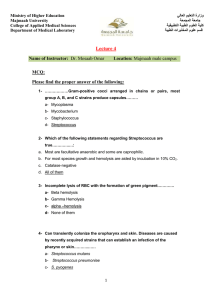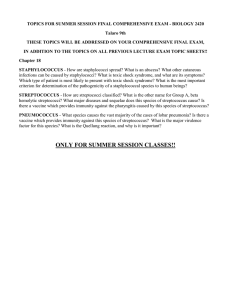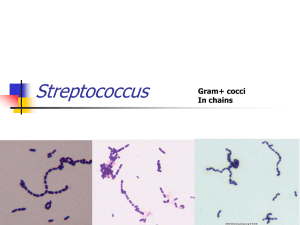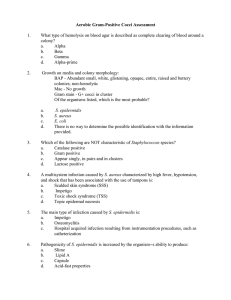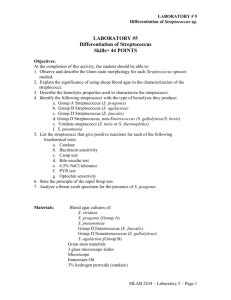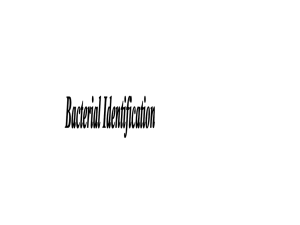LABORATORY #4 – 47 POINTS
advertisement
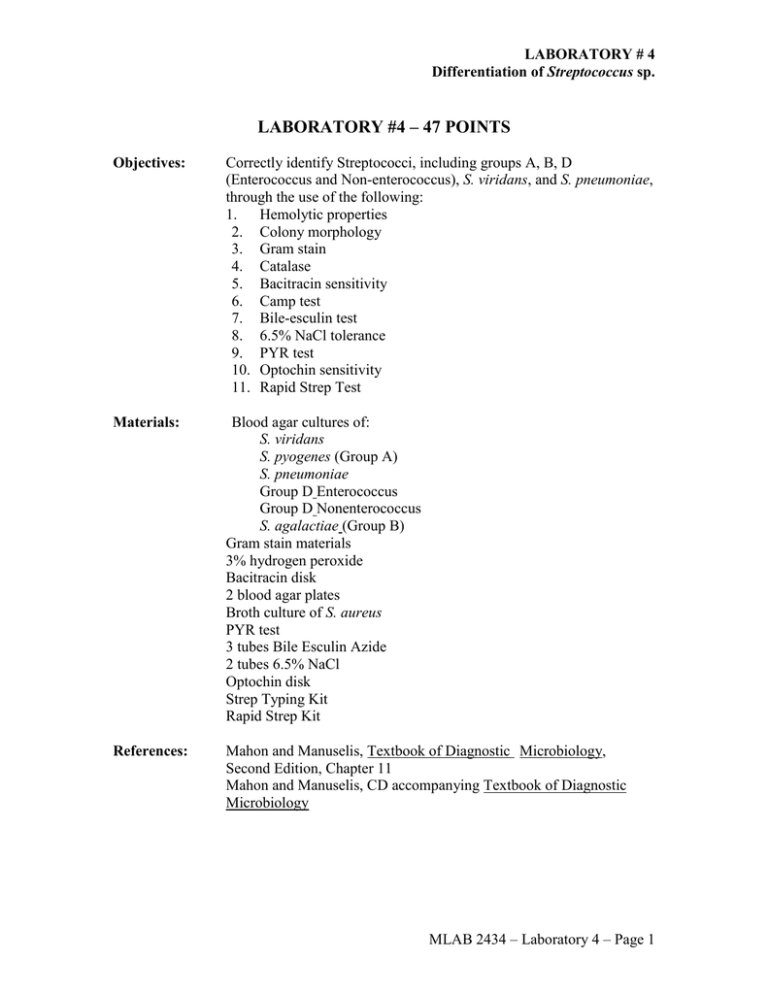
LABORATORY # 4 Differentiation of Streptococcus sp. LABORATORY #4 – 47 POINTS Objectives: Correctly identify Streptococci, including groups A, B, D (Enterococcus and Non-enterococcus), S. viridans, and S. pneumoniae, through the use of the following: 1. Hemolytic properties 2. Colony morphology 3. Gram stain 4. Catalase 5. Bacitracin sensitivity 6. Camp test 7. Bile-esculin test 8. 6.5% NaCl tolerance 9. PYR test 10. Optochin sensitivity 11. Rapid Strep Test Materials: Blood agar cultures of: S. viridans S. pyogenes (Group A) S. pneumoniae Group D Enterococcus Group D Nonenterococcus S. agalactiae (Group B) Gram stain materials 3% hydrogen peroxide Bacitracin disk 2 blood agar plates Broth culture of S. aureus PYR test 3 tubes Bile Esculin Azide 2 tubes 6.5% NaCl Optochin disk Strep Typing Kit Rapid Strep Kit References: Mahon and Manuselis, Textbook of Diagnostic Microbiology, Second Edition, Chapter 11 Mahon and Manuselis, CD accompanying Textbook of Diagnostic Microbiology MLAB 2434 – Laboratory 4 – Page 1 LABORATORY # 4 Differentiation of Streptococcus sp. Procedure: 1. Colony Morphology, Hemolytic Properties, Gram Stain, and Catalase In addition to being grouped according to serological properties, Streptococci may also be classified according to the type of hemolysis produced on sheep blood agar. The four types of hemolysis are alpha, beta, gamma, and alpha prime Alpha hemolysis is caused by partial lysis of the red cells in blood agar, allowing hemoglobin to be released and its subsequent degradation to biliverdin. It is characterized by an indistinct zone around the colony with a greenish or brownish discolorization. Beta hemolysis is caused by complete lysis of the red cells characterized by a clear, colorless zone around the colony. Gamma hemolysis is actually a misnomer in that there is no apparent hemolysis or discoloration around the colony of blood agar. Alpha prime hemolysis is an inner zone of alpha hemolysis and an outer zone of beta hemolysis. a. Describe the colony morphology and hemolytic properties of each Streptococcus isolate on the chart at the end of this exercise. b. Gram stain each strep and enter the results on the chart. c. Perform a catalase test on each strep . Be careful not to take any blood agar with the colonies! 2. Bacitracin Sensitivity Group A Streptococcus may be differentiated from other Streptococci by its sensitivity to low concentrations of bacitracin. A paper disk containing 0.04 U bacitracin (Taxo A) is placed on the thick part of a freshly streaked plate of suspected Group A strep. Any zone of inhibition of growth around the disk after overnight incubation is positive identification of Group A Streptococcus (S. pyogenes). Indicate the results for this organism on the chart. (See page 352 in text) 3. Camp Test Group B β-hemolytic streptococcus produces an extracellular enzyme, “CAMP” factor (an acronym of the authors who initially described this phenomenon). This CAMP factor intensifies the lysis of sheep red cells when placed in the appropriate inoculation points with S. aureus. The β-lysin produced by the staphylococci, in conjunction with the CAMP factor, produces an arrowhead-shaped hemolysis at the junction between the streptococci and staphylococci streaks. MLAB 2434 – Laboratory 4 – Page 2 LABORATORY # 4 Differentiation of Streptococcus sp. a. Inoculate a blood agar plate with S. aureus by making a single streak across the center of the plate. b. Streak the S. agalactiae (Group B) at right angle to the staphylococci streak, to within 2 mm. c. Incubate the plate overnight in a candle jar. d. Group B strep will exhibit an “arrowhead” of hemolysis. (See page 355 in text) 4. Group D Streptococcus Differentiation Group D streptococcus is a classification of strep that may produce either alpha, beta, or gamma hemolysis on sheep blood agar. It may be isolated from blood in subacute bacterial endocarditis, from specimens in urinary tract infections, or from wounds and deep abscesses. The Group D streptococci are divided into two groups: (1) Enterococci and (2) Nonenterococci. It is important that this differentiation be made because enterococci are less susceptible to penicillin than are other streptococci. In some cases of severe infection, combined therapy with two or more antimicrobial agents must be used. Bile Esculin Test The bile-esculin test is based on the ability of certain bacteria, notably the Group D streptococci, to hydrolyze esculin in the presence of 1% to 4% bile. Bacteria capable of growing in bile and also hydrolyzing esculetin produce glucose and the aglycone esculetin in an appropriate medium. Esculetin reacts with an iron salt to form a dark brown or black complex. a. Streak three (3) bile esculin slants heavily with S. agalactiae, S. faecalis, and S. bovis respectively. b. Incubate overnight and observe the slant for diffuse blackening of the slant, which is a positive reaction. (See page 356 in text) c. Record results. 6.5% NaCl Tolerance Once a streptococcus is identified as belonging to Group D (positive bile esculin reaction), it is necessary to determine whether it is an enterococcus or one of the nonenterococcus species. Enterococci will grow and produce acid in heart-infusion broth containing 6.5% sodium chloride; non-enterococci are inhibited from growing in this concentration of salt. Thus, with the bile-esculin and salt tolerance tests, three presumptive identifications are possible: 1) strains that are positive in both tests are enterococci; 2) strains that are negative in both tests belong to another streptococcus group; and 3) strains that give a positive bile-esculin test and no growth in 6.5% NaCl broth medium are presumptively termed non-enterococcal Group D streptococci. a. Inoculate two tubes of 6.5% NaCl medium with S. faecalis and S. bovis respectively. MLAB 2434 – Laboratory 4 – Page 3 LABORATORY # 4 Differentiation of Streptococcus sp. b. Incubate for 48 hours and observe for turbidity in the medium which indicates a positive test. c. Record results. PYR Tests Perform PYR testing on Group D Enterococcus and Group D Non-Enterococcus according to directions and record results. (See page 354 in text) 5. Optochin Susceptibility Optochin (ethylhydroxycupreine hydrochloride), a quinine derivative, selectively inhibits the growth of S. pneumoniae in very low concentration. Optochin may inhibit other alpha-hemolytic streptococci, but only at higher concentrations. a. Place a disk impregnated with optochin (Taxo P) on the thickly inoculated area of a blood agar plate of suspected S. pneumoniae. b. A zone of inhibition of growth ≥ 14 mm is considered a positive test for S. pneumoniae. (See page 366 in text) c. Record results. 6. Rapid StrepTests Throat swab specimens must be collected properly in order to obtain accurate results. Do not use calcium alginate swabs. For best results use a dacron or rayon swab for both the patient specimen and the Positive Control. Cotton swabs are not recommended as they tend to release fibers making the agglutination difficult to interpret; in addition, some are too tightly wound to deliver adequate volumes of extract onto the Test Plate. The swabbing technique used to collect the specimen is as important to the test result as is the performance of the test. The throat swab specimen must be collected under direct visualization with good lighting. The pharynx and tonsils must be adequately exposed and vigorously rubbed with a sterile rayon or Dacron® tipped swab. The tongue, uvula, and cheeks must be avoided. Any exudate present should also be touched with the swab. The swab can be tested immediately or held up to 72 hours. If culture results are desired, the swab may be streaked onto a blood agar plate before performing the Rapid Test. You will be given two (2) unknown swabs. Perform one of the direct antigen tests on each and record the results. Follow kit instructions. MLAB 2434 – Laboratory 4 – Page 4 LABORATORY # 4 Differentiation of Streptococcus sp. Presumptive Identification of Streptococci Test Group Group Enterococcus Grp. D, not Viridans, A B Enterococcus NonGrp. D Hemolysis β β* α,β,γ α,γ α,γ Bacitracin + -* -* -* +* CAMP +* -* -* -* Hippurate +* -* -* -* Bile-* +* +* -* Esculin 6.5% +* +* -* -* NaCl Optochin -* -* -* -* & Bile Solubility Catalase +* -* -* -* PYR + -* +* -* -* * Occasional exceptions occur. Pneumococci α ± + - MLAB 2434 – Laboratory 4 – Page 5 LABORATORY # 4 Differentiation of Streptococcus sp. Streptococcus Differentiation Name ___________________________________ Date _______________________ 1 point each Test Group A Group B Enterococcus Grp. D, NonEnterococcus Viridans, NonGrp. D Pneumococci Hemolysis Colony Morphology Gram Stain Catalase Bacitracin (Taxo A) CAMP Bile Esculin 6.5% NaCl PYR Optochin (Taxo P) MLAB 2434 – Laboratory 4 – Page 6 LABORATORY # 4 Differentiation of Streptococcus sp. Rapid Strep Testing Name ___________________________________ Date _______________________ 1 point each Results Kit Brand + Control - Control Lab Partner Unknown # ____ Unknown # ____ MLAB 2434 – Laboratory 4 – Page 7
